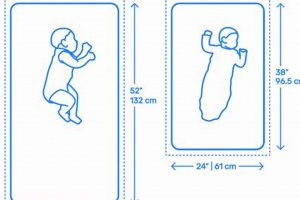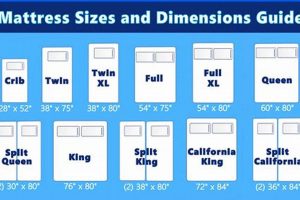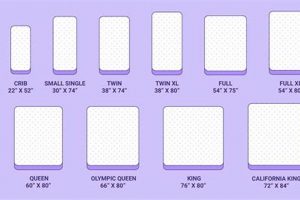The utmost dimensions available in standard bedding configurations typically reach a “Texas King” or “Alaskan King” classification. These oversized options extend well beyond the measurements of a traditional king-size bed, providing significantly increased surface area. For example, an Alaskan King often measures nine feet by nine feet, offering ample space.
The significance of these expanded sleeping platforms lies primarily in the enhanced comfort and accommodation they afford. Benefits include increased room for multiple sleepers, reduced motion transfer, and a greater sense of personal space during rest. Historically, custom-made bedding exceeding standard sizes has been available, but the emergence of readily available, albeit less common, designations like Alaskan King caters to a growing demand for larger sleeping surfaces.
The subsequent discussion will detail the specific measurements of these larger mattress types, explore the practical considerations involved in their selection and usage, and address common questions regarding their availability and associated accessories.
Considerations for Selecting the Utmost Mattress Dimensions
The acquisition of bedding with maximal surface area necessitates careful deliberation. Several factors impact the suitability of such a purchase.
Tip 1: Assess Spatial Constraints: Prior to acquisition, meticulously measure the intended bedroom. Ensure adequate clearance for movement around the perimeter of the bed frame and associated furniture. Neglecting this step can result in a cramped and impractical living space.
Tip 2: Evaluate Structural Integrity: Verify that the floor can support the substantial weight of an oversized mattress, frame, and occupants. Older structures or floors with known weaknesses may require reinforcement to prevent structural damage.
Tip 3: Budget for Specialized Bedding: Recognize that standard-size sheets, blankets, and comforters will not fit oversized mattresses. Factor in the cost of custom or specialty linens designed to accommodate the unique dimensions.
Tip 4: Determine Transportation Feasibility: Consider the logistical challenges of moving an extremely large mattress. Measure doorways, hallways, and stairwells to confirm that the mattress can be maneuvered into the desired location without difficulty.
Tip 5: Analyze Sleep Partner Preferences: If sharing the bed, discuss sleep preferences with the partner. While increased space can reduce motion transfer, individual comfort requirements should still be considered.
Tip 6: Research Available Models: Investigate manufacturers and retailers that offer oversized mattresses. Not all brands carry options exceeding standard king dimensions. Compare specifications and pricing to make an informed decision.
Tip 7: Consider Custom Options: If specific size requirements are not met by readily available options, explore the possibility of a custom-made mattress. This allows for precise tailoring to individual needs and spatial limitations.
Careful consideration of these factors ensures a more successful and satisfying experience when choosing bedding of substantial dimensions.
The subsequent sections will address specific product details and purchasing considerations for those pursuing the largest available mattress options.
1. Alaskan King Dimensions
The term “what is the largest mattress size” inevitably leads to the consideration of the Alaskan King. This is because, among readily available, non-custom mattress options, the Alaskan King often represents the upper limit of standard dimensions. The specific dimensions, typically 9 feet by 9 feet (108 inches by 108 inches), are a defining characteristic. A direct effect of these oversized measurements is the significant increase in sleeping surface area, benefiting individuals or couples who desire substantial personal space or those co-sleeping with children or pets. The importance of these dimensions lies in their ability to accommodate diverse sleeping arrangements and preferences, distinguishing the Alaskan King from smaller, more conventional sizes.
However, the relationship between the dimensions and practical application extends beyond mere comfort. The Alaskan King’s size presents logistical challenges, such as transportation and fitting it into standard-sized rooms. A real-life example illustrates this: an individual purchasing an Alaskan King must first ensure their bedroom possesses adequate space, accounting for both the mattress itself and surrounding furniture. Failure to consider these practicalities can result in significant inconveniences and necessitate alterations to the living space.
In conclusion, Alaskan King dimensions are a crucial component when answering the question “what is the largest mattress size,” but they also necessitate a comprehensive evaluation of spatial constraints and lifestyle considerations. While the increased sleeping area offers undeniable benefits, prospective buyers must carefully assess the logistical and financial implications to ensure the oversized mattress is a suitable addition to their home. The challenge lies not just in acquiring the largest possible mattress, but in effectively integrating it into a functional and comfortable living environment.
2. Texas King Specifications
The inquiry into “what is the largest mattress size” frequently includes an examination of the Texas King. While not the absolute largest available, its substantial dimensions make it a significant consideration. Its specifications offer a practical balance between ample sleeping space and feasibility of integration into residential environments.
- Nominal Dimensions
Texas King mattresses generally measure approximately 80 inches by 98 inches. This rectangular configuration provides extended length compared to standard king-size mattresses while maintaining a relatively manageable width. The dimensions impact suitability for taller individuals or those preferring more legroom.
- Surface Area Implications
The increased surface area offers enhanced comfort for couples or individuals who desire ample space. Motion transfer is reduced, contributing to undisturbed sleep. A real-world example is a couple where one partner is restless; the Texas King’s larger surface area mitigates the impact of their movements on the other partner’s sleep.
- Linen and Accessory Availability
Acquiring appropriately sized linens and accessories for a Texas King can present a challenge. While not as niche as the Alaskan King, specialized suppliers or custom orders are often required. This contrasts with standard sizes where a wider range of options are readily accessible.
- Room Size Requirements
The physical dimensions of a Texas King demand a proportionally sized bedroom. Insufficient space can lead to a cramped and uncomfortable living environment. Prior measurement and spatial planning are essential before purchase, mitigating potential integration issues.
The relationship between Texas King specifications and “what is the largest mattress size” lies in its position as a widely recognized, yet oversized, option. While custom creations may exceed its dimensions, the Texas King represents a balance of practicality and expansive sleeping surface. Its limitations in linen availability and spatial demands necessitate careful consideration but its advantages in comfort are self-evident.
3. Wyoming King Size
The consideration of “what is the largest mattress size” invariably leads to an evaluation of the Wyoming King size. The Wyoming King, characterized by its approximately 84-inch by 84-inch dimensions, occupies a significant position in the spectrum of oversized bedding. Its presence is a direct consequence of consumer demand for expanded sleeping surfaces exceeding the standard king size. Its importance stems from bridging the gap between standard sizes and the more extreme dimensions of options like the Alaskan King. For example, individuals seeking more space than a traditional king provides, but who lack the room or budget for a significantly larger custom option, might find the Wyoming King a suitable compromise. The practical significance of understanding this size lies in its availability as a readily obtainable, albeit specialized, mattress choice.
Further analysis reveals that the Wyoming King’s square configuration offers a unique distribution of space. This shape can be beneficial for couples with differing sleep habits or those co-sleeping with children, providing a balanced allocation of the sleeping area. Real-world scenarios include couples where one partner prefers to sprawl out during sleep; the square shape of the Wyoming King prevents one partner from encroaching excessively on the other’s space. The challenge, however, lies in sourcing appropriately sized bedding. While more accessible than Alaskan King linens, Wyoming King sheets and comforters are not universally stocked and may require specialized orders, increasing the overall cost. Its accessibility makes this size a better option to have rather than choosing custom made.
In conclusion, the Wyoming King size serves as a crucial component in understanding “what is the largest mattress size” from a practical perspective. While it is not the absolute maximum dimension available, its relatively wider availability and manageable form factor make it a viable option for those seeking enhanced sleeping space without the logistical complexities of more extreme sizes. The balance between spaciousness and practicality defines its significance in the spectrum of oversized bedding, and therefore, for those with space and comfort. Further research will be needed before making any move to order one online.
4. Custom Mattress Potential
The pursuit of “what is the largest mattress size” often culminates in the exploration of custom mattress potential. While standard mattress sizes, such as the Alaskan King or Texas King, represent established limits, the option for custom fabrication transcends these boundaries. The capacity to commission a bespoke mattress introduces a variable upper limit to the question. The importance of recognizing custom potential lies in the acknowledgment that the definition of “largest” is not fixed, but rather contingent upon individual needs and spatial constraints. For example, an individual with a uniquely shaped bedroom might require a mattress exceeding standard dimensions in one axis but constrained in another, necessitating a custom design. The effect is a personalized solution that defies pre-defined size categories. The potential for custom dimensions effectively eliminates the fixed upper bound previously associated with standard mattress sizes.
Further analysis reveals that custom mattress potential extends beyond simply increasing overall dimensions. Customization allows for the incorporation of specific materials, firmness levels, and support systems tailored to individual preferences. An individual with chronic back pain might specify a particular coil configuration and foam density in their custom mattress, irrespective of its size. Real-world applications include the creation of mattresses that seamlessly integrate with existing bedroom furniture or accommodate specific medical requirements. The practical applications are extensive, ranging from accommodating unique architectural spaces to addressing specific health concerns. The use of design options, the options available can be endless.
In conclusion, the understanding of custom mattress potential is critical when addressing “what is the largest mattress size.” Custom fabrication removes the dimensional limitations imposed by standardized options, allowing for the creation of mattresses tailored to unique needs and spatial constraints. The challenges involve navigating the complexities of custom design and manufacturing, as well as potentially higher costs compared to standard sizes. However, the ability to define the “largest” mattress according to individual specifications underscores the significance of considering custom options within the broader context of bedding selection. Therefore, before deciding any plans to create custom mattress one must do deeper research and contact the experts in making custom mattresses.
5. Accessibility Challenges
The pursuit of definitive information on “what is the largest mattress size” is intrinsically linked to accessibility challenges. These challenges encompass the logistical difficulties associated with transporting, installing, and utilizing oversized mattresses within typical residential environments. The sheer size of these mattresses presents significant obstacles not encountered with standard-sized bedding. The importance of recognizing these accessibility challenges stems from their potential to negate the perceived benefits of an oversized mattress. For example, a consumer may desire an Alaskan King for its expansive sleeping surface, but if the mattress cannot physically be maneuvered through doorways or up stairwells, the purchase becomes impractical. The defining characteristic of this connection lies in the physical limitations imposed by standard architectural designs relative to the extreme dimensions of certain mattresses.
Further analysis reveals that accessibility challenges extend beyond mere physical transport. The increased weight of oversized mattresses can pose structural concerns for flooring, potentially requiring reinforcement. A real-world scenario might involve an older home with a weight-bearing capacity insufficient to support a large mattress and its occupants. The placement of the mattress within the bedroom presents additional considerations. Adequate clearance for movement around the bed is essential, and smaller rooms may become cramped and unusable with the addition of an oversized mattress. Customization helps for better and comfortable mattress.
In conclusion, the interaction between accessibility challenges and “what is the largest mattress size” is a crucial consideration. The physical limitations imposed by doorways, stairwells, room dimensions, and floor load-bearing capacity significantly influence the feasibility and practicality of acquiring an oversized mattress. The challenges in maneuvering the items may give the customer stress. The successful integration of such a mattress requires careful pre-purchase planning and assessment of the intended environment. Without due diligence, the desire for an expansive sleeping surface may be overshadowed by logistical difficulties, diminishing the overall value and utility of the purchase.
6. Linen Availability
The inquiry into “what is the largest mattress size” cannot be fully addressed without a thorough understanding of linen availability. The correlation between mattress size and the accessibility of appropriately sized linens is a significant factor that impacts the practicality and overall satisfaction associated with oversized bedding.
- Standard Size Limitations
Standard linen sizes are designed to fit common mattress dimensions, such as twin, full, queen, and king. As mattress size increases beyond these norms, the availability of pre-made linens diminishes significantly. For instance, while king-size sheet sets are readily available, finding appropriately sized linens for an Alaskan King or custom-dimensioned mattress requires specialized sourcing.
- Specialized Retailers and Custom Orders
Oversized mattress linens are typically found at specialized retailers or require custom manufacturing. This reduced availability translates to higher costs and longer lead times. A consumer seeking sheets for a Texas King might need to order from a manufacturer specializing in oversized bedding, adding to the overall expense and delaying the bedding’s usability.
- Material Options and Design Choices
Linen availability also impacts the range of material options and design choices. While standard sizes offer a vast selection of cotton, linen, silk, and synthetic blends, oversized linens may be limited to a smaller selection of materials and patterns. This restricts the consumer’s ability to fully personalize their sleep environment to match their aesthetic preferences. The amount of selection on the material is based on the manufacturer.
- Cost Considerations
The economic impact of linen availability is substantial. Custom-made linens can cost significantly more than their standard-sized counterparts, adding a considerable expense to the initial mattress purchase. This price discrepancy should be a primary consideration for consumers evaluating oversized mattresses. This should be part of the budget as well so that the consumer can weigh their options.
In summary, linen availability forms a critical component in the question of “what is the largest mattress size.” The limited accessibility, reduced material options, and increased costs associated with oversized linens must be carefully weighed against the perceived benefits of a larger sleeping surface. A comprehensive assessment of these factors ensures a more informed and practical decision when selecting oversized bedding and should be taken into careful consideration.
7. Frame Support Requirements
The pursuit of defining “what is the largest mattress size” is inextricably linked to frame support requirements. The physical dimensions and weight characteristics of oversized mattresses necessitate robust and appropriately designed support structures. The structural integrity of the frame directly impacts the longevity, safety, and overall usability of the bedding system.
- Load-Bearing Capacity
The frame must possess sufficient load-bearing capacity to withstand the combined weight of the mattress, sleepers, and any bedding materials. Exceeding the frame’s weight limit can result in structural failure, compromising the stability and safety of the bed. An example of this, a poorly constructed frame beneath an Alaskan King, could buckle under the significant weight, leading to potential injury. Such a structural issue could leave the user to experience injuries and even possible lawsuits against the maker.
- Material Composition and Construction
The material composition and construction techniques employed in the frame’s manufacture are crucial determinants of its strength and durability. Solid wood frames, reinforced steel frames, or combinations thereof are often necessary to adequately support larger mattresses. Inferior materials or construction can lead to premature wear, instability, and potential collapse under the sustained weight. The construction should meet the standard to ensure its quality.
- Center Support Systems
Oversized mattresses typically require enhanced center support systems to prevent sagging and maintain uniform weight distribution across the sleeping surface. Center support systems may include additional legs, crossbeams, or reinforced slats. The absence of adequate center support can lead to uneven wear on the mattress and compromise sleep quality. It may be a hassle if the center support system is not properly made.
- Dimensional Compatibility
The frame must be dimensionally compatible with the specific measurements of the mattress to ensure proper fit and prevent movement or instability. Mismatched dimensions can result in gaps, overhangs, or inadequate edge support, compromising both comfort and safety. The dimensions should always be correct to prevent the customer from experiencing trouble.
In conclusion, the frame support requirements are not simply an ancillary consideration but an integral aspect of “what is the largest mattress size.” The appropriate selection and construction of a robust frame are paramount to ensuring the safety, longevity, and optimal performance of oversized bedding systems. Neglecting these considerations can undermine the intended benefits of a larger sleeping surface and introduce significant structural risks. A failure to inspect or properly install the items could give the user several problems when it comes to the usage of the frame.
Frequently Asked Questions
The following section addresses common inquiries and clarifies key considerations regarding mattress dimensions, focusing on the upper limits of available sizes.
Question 1: What is the absolute largest mattress size commercially available without custom fabrication?
While dimensions may vary slightly by manufacturer, the Alaskan King mattress, measuring approximately 9 feet by 9 feet (108 inches by 108 inches), is generally considered the largest readily available, non-custom option.
Question 2: Beyond the sleeping surface, what other spatial considerations are critical when choosing an oversized mattress?
Essential spatial factors include adequate bedroom dimensions to accommodate the mattress and surrounding furniture, hallway and doorway widths to facilitate delivery, and floor load-bearing capacity to support the mattress and occupants’ combined weight.
Question 3: Are specialized linens required for oversized mattresses, and how does this impact cost?
Yes, standard-size linens will not fit oversized mattresses. Specialized linens, often requiring custom orders or sourcing from niche retailers, represent a significant additional expense compared to standard bedding.
Question 4: What structural considerations are necessary to support an oversized mattress?
A robust frame with adequate load-bearing capacity is paramount. Solid wood or reinforced steel frames with enhanced center support systems are typically required to prevent sagging and ensure stability.
Question 5: Is it possible to combine two standard mattresses to achieve a larger sleeping surface?
While technically feasible, combining mattresses is generally not recommended. Differing mattress heights, firmness levels, and construction can create uneven sleeping surfaces and compromise comfort and support.
Question 6: Do oversized mattresses offer any specific benefits beyond increased sleeping space?
Beyond increased space, potential benefits include reduced motion transfer, enhanced comfort for multiple sleepers, and a greater sense of personal space during rest. However, these benefits must be weighed against the logistical and financial considerations.
In summary, determining the largest mattress size is not simply a matter of finding the greatest dimensions. Practical considerations such as spatial limitations, linen availability, and structural support are equally important. A comprehensive assessment of these factors ensures a more informed and satisfactory purchase.
The next section will explore specific retailers and manufacturers that offer oversized mattresses, providing further guidance for consumers seeking these specialized products.
Conclusion
This exploration has illuminated the multi-faceted nature of “what is the largest mattress size.” While specific dimensions, such as those characterizing the Alaskan King, provide a quantitative answer, a complete understanding necessitates consideration of spatial constraints, structural support, linen availability, and custom fabrication options. The practical upper limit is defined not merely by physical measurements but also by the feasibility of integrating such a mattress into a functional living space.
The decision to acquire an oversized mattress, therefore, demands careful evaluation. Future trends may see increased availability of standardized larger sizes or advancements in custom fabrication techniques, broadening consumer choice. However, the core principles of assessing individual needs, spatial limitations, and logistical implications will remain paramount for informed decision-making in the pursuit of optimal sleep solutions.







